| Pages:
1
..
22
23
24
25
26 |
B(a)P
International Hazard
    
Posts: 1132
Registered: 29-9-2019
Member Is Offline
Mood: Festive
|
|
Quote: Originally posted by dettoo456  | Anyone had experience with Silver 5-ATz complexes such as [(2Ag)5-ATz] NO3 or ClO4? The perchlorate is mentioned in engager’s tetrazole write up and
a patent but there doesn’t seem to be much discussion on it. I tried to make the nitrate the other day according to klapotke’s procedure (https://pubmed.ncbi.nlm.nih.gov/19105192/) but it didn’t seem to yield anything that great. To start, 5-ATZ doesn’t dissolve that great in
conc (anything higher than azeo %) Nitric Acid, and if you add too much water, the complexation time with AgNO3 can be ruined by just dumping out the
Silver salt of 5-ATz. Too high conc of acid will form the 5-ATz nitrate salt instead which has low solubility as well and hinders complexation as
well.
My product crashed out of the sol immediately on addition of AgNO3 to the 5-ATz/HNO3 mix as an off-white precipitate that started to yellow to a
pastel yellow on air drying on a filter.
The product is supposed to detonate on flame contact and indirectly at 298C. For me, it does crackle faintly but I can’t seem to get it to dry. I
would wager it’s like AgNTz in that it is a pain to detonate when wet but really goes when dry, but I can’t get this complex to dry to see
anything amazing.
This salt could be a great alternative to LA, nitrotetrazoles, and such since it’s so seemingly easy to prepare, but I can’t get make it to match
klapotke’s results. -My HNO3 and AgNO3 are pure and my 5-ATz is decently pure so idk. |
I have previously made a complexes with 5ATZ and nickel perchlorate as well as copper chlorate. The nickel perchlorate complex is not too friction or
impact sensitive and detonates from flame in the smallest amount. I have not done any real tests on it though. The copper chlorate complex was
somewhat sensitive to impact, but not friction and also detonated from flame in small amounts. The copper chlorate complex decomposed on standing for
about a week. I have a bunch of similar complexes that I would also like to test including silver, so interesting to hear your observation.
|
|
|
Microtek
National Hazard
   
Posts: 845
Registered: 23-9-2002
Member Is Offline
Mood: No Mood
|
|
I have experimented with the silver 5-ATz perchlorate some years ago. IIRC, it worked fine, and was quite responsive to flame (no issues getting it
dry). It did discolour over time, though that may have been due to residual silver nitrate rather than decomposition of the complex itself. I didn't
see anything to prefer it over some of the other high performance primaries though.
|
|
|
dettoo456
Hazard to Others
  
Posts: 218
Registered: 12-9-2021
Member Is Offline
|
|
Thanks for input. I’d agree that it might not be the best compared to even more accessible Ni and Co salts, but I figured it’d be a better
alternative to the NTz’s since you wouldn’t need to go through the NaNTz prep. I’ll have to try the Ni salt sometime.
AgNTz has always been consistently good for anything I need out of it.
|
|
|
Microtek
National Hazard
   
Posts: 845
Registered: 23-9-2002
Member Is Offline
Mood: No Mood
|
|
I didn't mean to imply that there isn't a use case for silver 5-ATz perchlorate, just that when I experimented with it I also had numerous
nitrotetrazoles, NAP and others. So compared to the others, it didn't arouse my interest.
|
|
|
dettoo456
Hazard to Others
  
Posts: 218
Registered: 12-9-2021
Member Is Offline
|
|
Oh ok, I understand what you mean. I did manage to dry the SAN (I’ll just use that acronym to make it easy) and it does seem to perform the way
Klapotke described it to; flame sensitive to complete detonation with a pretty powerful effect. The friction, impact, & shock sensitivity all seem
low though - hammer on hardened steel doesn’t do anything and putting a dried chunk between the contacts of a blasting machine (2J @ 225V) doesn’t
do anything. Also, its flame sensitivity seems mild compared to AgNTz. I am able to wave a flame in front of it without setting it off but if I hold
for about 1/2 second, it’ll detonate.
I am going to try storing it underwater and in dry-contact with HDPE, Al, brass, and Cu to get an idea of storage stability.
[Edited on 27-11-2023 by dettoo456]
[Edited on 27-11-2023 by dettoo456]
|
|
|
MineMan
National Hazard
   
Posts: 998
Registered: 29-3-2015
Member Is Offline
Mood: No Mood
|
|
Quote: Originally posted by dettoo456  | Oh ok, I understand what you mean. I did manage to dry the SAN (I’ll just use that acronym to make it easy) and it does seem to perform the way
Klapotke described it to; flame sensitive to complete detonation with a pretty powerful effect. The friction, impact, & shock sensitivity all seem
low though - hammer on hardened steel doesn’t do anything and putting a dried chunk between the contacts of a blasting machine (2J @ 225V) doesn’t
do anything. Also, its flame sensitivity seems mild compared to AgNTz. I am able to wave a flame in front of it without setting it off but if I hold
for about 1/2 second, it’ll detonate.
I am going to try storing it underwater and in dry-contact with HDPE, Al, brass, and Cu to get an idea of storage stability.
[Edited on 27-11-2023 by dettoo456]
[Edited on 27-11-2023 by dettoo456] |
What compound is this? How does it compare to NAP?
|
|
|
dettoo456
Hazard to Others
  
Posts: 218
Registered: 12-9-2021
Member Is Offline
|
|
Disilver salt of 5-aminotetrazolium nitrate. Literature stated properties are only related to sensitivity and include: ESD sensitive, impact sens of
15J, friction sens of 18N, Tdecomp @ 298C, and a fast ddt (detonates on flame contact). My own findings generally match those in the literature. The
energetic properties most likely match or exceed those of NAP simply due to the coordination of Ag and the BDEs in 5-ATz.
But NAP is cheaper and more easily sourced, plus its amateur reporting is far wider in scope.
|
|
|
Microtek
National Hazard
   
Posts: 845
Registered: 23-9-2002
Member Is Offline
Mood: No Mood
|
|
Hmm, I only experimented with the perchlorate variant but those numbers look enticing. Maybe I will give it a shot to see if the product is also
sufficiently stable. In indoor testing, the HCl fumes from perchlorate salts have to be taken into account; nitrates do not have this problem. As far
as I know, silver also has low toxicity.
|
|
|
B(a)P
International Hazard
    
Posts: 1132
Registered: 29-9-2019
Member Is Offline
Mood: Festive
|
|
Quote: Originally posted by dettoo456  | Disilver salt of 5-aminotetrazolium nitrate. Literature stated properties are only related to sensitivity and include: ESD sensitive, impact sens of
15J, friction sens of 18N, Tdecomp @ 298C, and a fast ddt (detonates on flame contact). My own findings generally match those in the literature. The
energetic properties most likely match or exceed those of NAP simply due to the coordination of Ag and the BDEs in 5-ATz.
But NAP is cheaper and more easily sourced, plus its amateur reporting is far wider in scope. |
Do you mind sharing the full pdf of the paper you referenced or more detail on the procedure that you used? I am curious to give this a go also.
|
|
|
EF2000
Hazard to Others
  
Posts: 144
Registered: 10-5-2023
Location: The Steppes
Member Is Offline
Mood: wrooom
|
|
Quote: Originally posted by B(a)P  |
Do you mind sharing the full pdf of the paper you referenced or more detail on the procedure that you used? I am curious to give this a go also.
|
Here's the paper
Attachment: konstantin-karaghiosoff-energetic-silver-salts-with-5.pdf (742kB)
This file has been downloaded 165 times
Wroom wroom
"Head is a terrible thing to lose" - Tolle Koenig
|
|
|
dettoo456
Hazard to Others
  
Posts: 218
Registered: 12-9-2021
Member Is Offline
|
|
A word of warning though to those trying anything with AgNTz or this silver complex; the AgNTz (and probably the compex) ARE NOT COMPATIBLE with
Aluminum metal or materials like Tetrazene & MTX-1. The 5-AgNTz is compatible with cyclic nitramines, copper, and brass.
‘New’ primaries such as NAP and the silver salts described can carry serious dangers if not handled properly. Even milligram amounts can and will
mame through microshrapnel if they go off prematurely. Please keep surfaces grounded and wear googles/faceshield.
|
|
|
B(a)P
International Hazard
    
Posts: 1132
Registered: 29-9-2019
Member Is Offline
Mood: Festive
|
|
Thanks very much for the paper EF2000. Also thank you dettoo456 for the word of warning regarding various compatibilities. I have done quite a bit of
testing for the compatibility of NAP with various metals and am yet to find one that it does not appear to be compatible with. My results are however
inconclusive, because some of my NAP decomposed due to what I believe to be improper synthesis (having the final product in water for too long). I
will report back when/if I find otherwise.
Quote: Originally posted by dettoo456  | To start, 5-ATZ doesn’t dissolve that great in conc (anything higher than azeo %) Nitric Acid, and if you add too much water, the complexation time
with AgNO3 can be ruined by just dumping out the Silver salt of 5-ATz. Too high conc of acid will form the 5-ATz nitrate salt instead which has low
solubility as well and hinders complexation as well.
This salt could be a great alternative to LA, nitrotetrazoles, and such since it’s so seemingly easy to prepare, but I can’t get make it to match
klapotke’s results. -My HNO3 and AgNO3 are pure and my 5-ATz is decently pure so idk. |
They don't report and difficulty in their method in the paper, are these your own personal observations? I will try to make time to perform some
similar experiments this weekend and report back on what I find.
|
|
|
dettoo456
Hazard to Others
  
Posts: 218
Registered: 12-9-2021
Member Is Offline
|
|
Those are the issues I had. I will try to re-synth the complex when I get time as well.
|
|
|
B(a)P
International Hazard
    
Posts: 1132
Registered: 29-9-2019
Member Is Offline
Mood: Festive
|
|
Unfortunately my weekend has become filled with domestic tasks, so it will be at least a few days before I try. I will keep your observations in mind
and see if I can replicate the issue and find a way around them.
|
|
|
MineMan
National Hazard
   
Posts: 998
Registered: 29-3-2015
Member Is Offline
Mood: No Mood
|
|
Those sensitivities are impressive. The copper version of NAP is 2J impact but 20N friction if I remember. I regard friction as more important. There
are primaries that are immune to friction. This does look like a complex snyth tho. Wish the friction was less sensitive
|
|
|
MineMan
National Hazard
   
Posts: 998
Registered: 29-3-2015
Member Is Offline
Mood: No Mood
|
|
Quote: Originally posted by dettoo456  | A word of warning though to those trying anything with AgNTz or this silver complex; the AgNTz (and probably the compex) ARE NOT COMPATIBLE with
Aluminum metal or materials like Tetrazene & MTX-1. The 5-AgNTz is compatible with cyclic nitramines, copper, and brass.
‘New’ primaries such as NAP and the silver salts described can carry serious dangers if not handled properly. Even milligram amounts can and will
mame through microshrapnel if they go off prematurely. Please keep surfaces grounded and wear googles/faceshield. |
Grounding electronic mats? Yes they have thin steel spectra gloves that don’t take any dexterity away.
|
|
|
MineMan
National Hazard
   
Posts: 998
Registered: 29-3-2015
Member Is Offline
Mood: No Mood
|
|
Those sensitivities are impressive. The copper version of NAP is 2J impact but 20N friction if I remember. I regard friction as more important. There
are primaries that are immune to friction. This does look like a complex snyth tho. Wish the friction was less sensitive
|
|
|
Microtek
National Hazard
   
Posts: 845
Registered: 23-9-2002
Member Is Offline
Mood: No Mood
|
|
I wouldn't say that the synthesis is particularly complex; you are simply adding silver nitrate soln to a suspension of aminotetrazole in nitric acid.
The problem is that the synthesis seems to be quite sensitive to small variations in the experimental parameters.
I tried it the other day, and the product I got was energetic, but not imressively so. On flame contact it puffs off with evolution of distinctly
yellowish smoke and when wrapped in Al-foil it explodes with moderate violence. However, 40 mg fuse initiated in a plastic pipe only burns.
It is possible that my nitric isn't quite concentrated enough - it has been a while since last I titrated it.
[Edited on 4-12-2023 by Microtek]
|
|
|
dettoo456
Hazard to Others
  
Posts: 218
Registered: 12-9-2021
Member Is Offline
|
|
I’ve had the same issues when confining the compex in a brass shell and trying to initiate with bickford fuse; it finds a way to burn/puff out
without shattering the metal tube. Also, when dry and in contact with flame to detonate, it does detonate but clearly doesn’t have the same power as
other salts. It’s subjective since it isn’t feasible to determine VOD and brisance from just sight and hearing, but NaNTz, for example, is
noticeably more violent than the SAN.
I will try to confine the SAN with some nitrocellulose next to the bickford fuse and see if that gets it going. I have a feeling the high tDecomp is
causing it to be too insensitive to flame/sparks from something like common cannon fuse.
Also, my SAN has fully discolored at this point (about 2 weeks storage) to a pastel yellow. I don’t think that’d affect performance but who knows.
Yellow chemistry has never been detrimental to me, only an aesthetic nuisance.
|
|
|
B(a)P
International Hazard
    
Posts: 1132
Registered: 29-9-2019
Member Is Offline
Mood: Festive
|
|
Quote: Originally posted by Microtek  | I wouldn't say that the synthesis is particularly complex; you are simply adding silver nitrate soln to a suspension of aminotetrazole in nitric acid.
The problem is that the synthesis seems to be quite sensitive to small variations in the experimental parameters.
I tried it the other day, and the product I got was energetic, but not imressively so. On flame contact it puffs off with evolution of distinctly
yellowish smoke and when wrapped in Al-foil it explodes with moderate violence. However, 40 mg fuse initiated in a plastic pipe only burns.
It is possible that my nitric isn't quite concentrated enough - it has been a while since last I titrated it.
[Edited on 4-12-2023 by Microtek] |
I tried this earlier in the week and got the same result. I generally followed the procedure in the referenced paper, except that I added a heating
step following completion of the addition of silver nitrate. I had no issue with getting the product dry.
|
|
|
Nemo_Tenetur
Harmless

Posts: 28
Registered: 13-12-2023
Location: Germany
Member Is Offline
|
|
DPPE-1 synthesis and some testing
Inspired by the recent publication in nature communications, I´ve decided to synthesize this brand new primary.
Due to the largely unknown properties is protection equipment a must:
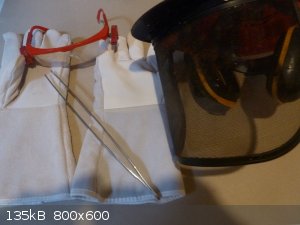
My lab scale is not precise enough to weigh out milligram quantities. So I used the ten-fold quantity (3,7 gram DABCO-dihydrochloride and 0,55 gram
ammonium chloride in 50 ml H20 for solution A and 12,8 gram sodium periodate in 80 ml H2O for solution B:
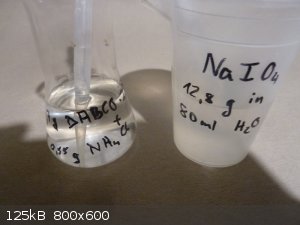
The first attempt was performed with 2,5 ml solution A and 4 ml solution B. The expected yield is about 500 mg. This should be enough for several
tests, but not too much to avoid serious damage with remote handling.
To reduce friction and minimize the damage (avoid glass shrapnel) in the case of an unexpected explosion I used hdpe-plastic reaction vessel and hdpe
pipette for stirring. Aqueous solutions at room temperature is really a benefit.
Exactly as described, a few seconds after the combination of the solutions a white crystalline precipitate appear at the bottom of the vessel:
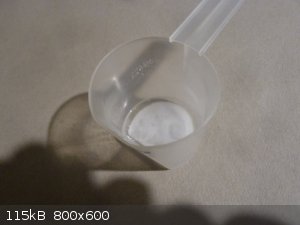
The filtration performs well and the filter was washed three times with several ml cold distilled water. Then the filter paper was transferred
together with the still wet crystalline product into a flat plastic bowl. The still wet batch was remotely divided in four almost equal-sized parts,
to reduce damage in the case of an unexpected explosion.
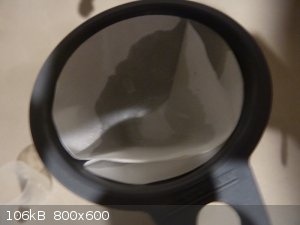
After drying over-night it looks macroscopically like table-salt, it is free-flowing.
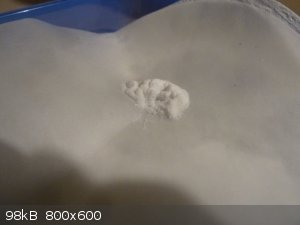
A matchhead-quantity was wrapped in a layer of thin aluminum foil. The explosion occured after a second exposure to a blue gas flame of a bunsen
burner, the aluminum foil was shattered:

The wet product, however, ist not so sensitive to the flame. Some weak plop-plop, but no real explosion. After a few seconds in the flame, the sound
becomes somewhat stronger:
Attachment: DPPE-1 wet.mp4 (771kB)
This file has been downloaded 114 times
The completely dry product detonates immediately without confinement even in matchhead-quantites:
Attachment: DPPE-1 dry.mp4 (166kB)
This file has been downloaded 116 times
A large orange-brown cloud is evolved immediately after detonation, visible in slow-motion:
Attachment: DPPE-1 dry slow-motion.mp4 (254kB)
This file has been downloaded 126 times
The dry product is quite sensitive to friction and impact. A matchhead quantity placed on concrete floor hit with the top of a pliers set it off (no
excessive force necessary, just a slap out of my wrist).
|
|
|
dettoo456
Hazard to Others
  
Posts: 218
Registered: 12-9-2021
Member Is Offline
|
|
Great work, your product looks to be exactly what the literature described. Tuning might be possible through use of cheaper and more accessible ClO4-
instead of IO4- (the perchlorate should also be more stable), as well as maybe modifying the diamine by introducing more carbon. Though, I doubt
something like hexamine would form a complex in the same way the DABCO and piperazine could.
|
|
|
Nemo_Tenetur
Harmless

Posts: 28
Registered: 13-12-2023
Location: Germany
Member Is Offline
|
|
Well, perchlorate is much cheaper than periodate. I´ve paid 330 Euro for one kilogram sodium periodate, this is more than enough for the rest of my
life. Potassium perchlorate availability for the general public is highly restricted in the European Union (EU-regulation 2019/1148):
https://www.legislation.gov.uk/eur/2019/1148/data.pdf
In Germany, the mere possession of sodium and potassium perchlorate is a crime and can be punished with incarceration up to three years:
https://www.gesetze-im-internet.de/ausgstg/__13.html
The law has some loopholes (i.e. sodium and potassium perchlorate is restricted, but not perchloric acid itself), but I guess this is just a matter of
time to get closed.
|
|
|
Microtek
National Hazard
   
Posts: 845
Registered: 23-9-2002
Member Is Offline
Mood: No Mood
|
|
| Quote: |
A matchhead quantity placed on concrete floor hit with the top of a pliers set it off (no excessive force necessary, just a slap out of my wrist).
|
This sounds as if it is much more sensitive than NAP, NiCP and related compounds. They require hammer blows that are powerful enough to break bones.
|
|
|
Nemo_Tenetur
Harmless

Posts: 28
Registered: 13-12-2023
Location: Germany
Member Is Offline
|
|
Yes, I think it´s too sensitive for a broad application (apart from the relatively low thermal stability) and I doubt that the reported IS value 3,5
Joule is in accordance with my sample. It is also conceivable that slight changes in the manufacturing process (temperature, concentration, stirring
velocity, impurities etc.) are of great influence for the properties of the final product.
Yesterday I´ve tried to set up an improvised "BAM-Fallhammerapparat" to measure the impact sensitivity of my sample, but after several trials I gave
it up. This is nothing you can do with "ghetto style" equipment and expect reliable results. An internet search revealed that it is really a challenge
to get an exact and reproducible value. Even the BAM federal agency in Germany (with state of the art equipment) emphasize the trouble and problems in
this area ("Herausforderung für die Qualitätssicherung"):
https://opus4.kobv.de/opus4-bam/frontdoor/index/index/docId/...
My original intention was to test this primary for squibs. Squibs are hard to get and very expensive here. Unfortunately, even small quantities
produce a visible orange-brown cloud.
Maybe this is usable as a kind of "reactive target" for airguns? Like matchtape, with a spot primary below adhesive strips? It should be initiated
from a low velocity airgun pellet, if I estimate the impact sensitivity correct.
|
|
|
| Pages:
1
..
22
23
24
25
26 |